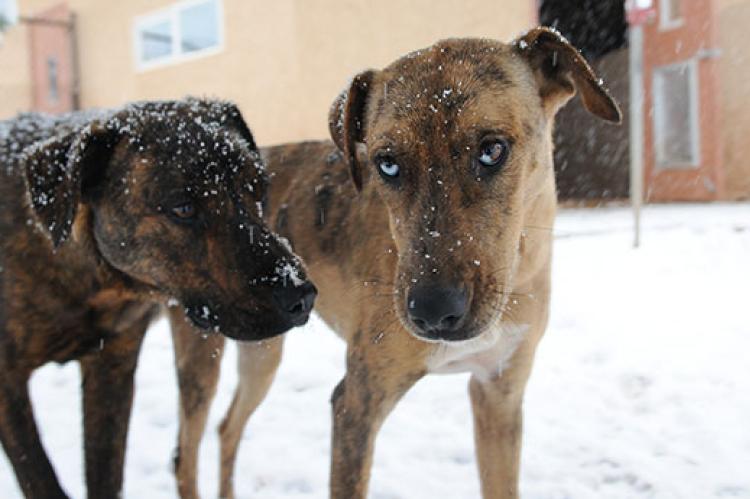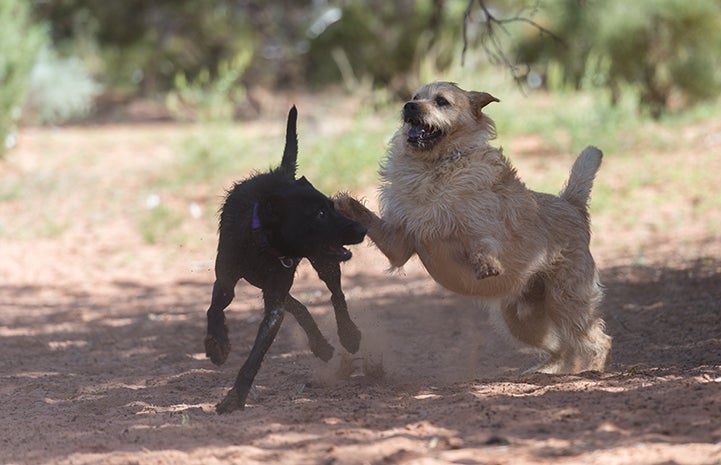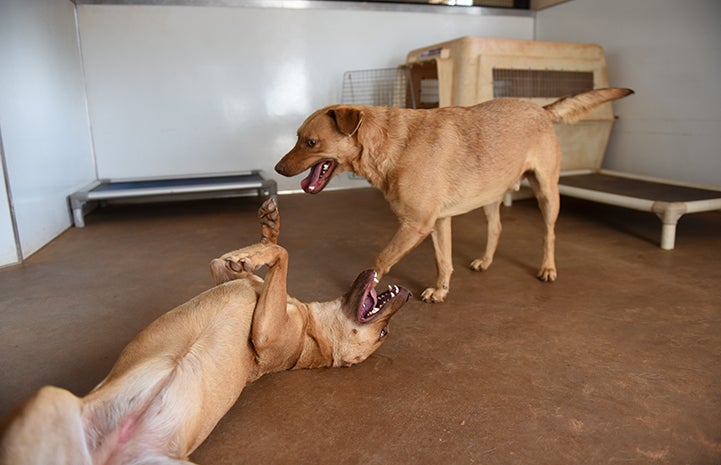How to Introduce Dogs to Each Other

If you have a dog and a new canine will be entering your home, there are steps you can take to ensure that the meeting goes off without a hitch. Regardless of whether the new dog is a foster pet, a new family member, or just a visitor, here are some tips for how to introduce dogs to each other.
Factors that can influence how dogs interact
Many dogs have forgotten (or never learned) how to properly greet other members of their own species. Dogs are mostly on leashes, behind fences, rushed into greetings by their well-meaning people, or kept from situations that would otherwise help them learn canine greeting etiquette.
Holding a dog on a tight leash can create frustration when your dog sees other dogs on the street, and that can cause body language in your dog that might look offensive to other dogs. Certain canine behavior, including pulling on leash, a hard stare, and running directly up to other dogs, can turn greetings sour.
Before you set up a dog introduction, consider your dog’s general attitude toward other dogs. All dogs are individuals. Some are uncomfortable with or reactive to new dogs and need very slow introductions. Some don't necessarily like every single dog they meet. And some do best as the only dog in the household.

How to introduce dogs properly
First impressions matter, so it’s important to properly introduce your current dog to a new dog. You don’t want to walk a new dog into your home with your current dog waiting inside because your dog will naturally feel that the newcomer is an intruder, not a new friend. Properly introduced dogs are more likely to become buddies. But starting them off on the wrong foot could lead to a longer period of letting them acclimate and become comfortable with each other.
Here's how to introduce dogs initially for the best chance of success:
- Enlist someone to go on a walk with you, with each of you walking one dog. Walk parallel to each other, starting around 20 feet apart.
- If the dogs pull toward each other, stare at each other, or are overly excited, you are too close too soon. Put some distance between the dogs, and have them just hang out for a bit at that distance before continuing to walk.
- Use treats to reward the dogs for remaining calm and focusing on who's walking them. This gives them something to do while they get used to each other’s presence. Be patient and relaxed, so the dogs can relax, too.
- At some point, the dogs should become calmer, and you can proceed with your walk. What you are looking for is relaxed and confident behavior. Neither dog should be overly aroused, nervous, stiff, or fearful. Keep in mind that it can take more than one walk to see this relaxed behavior.
If the dogs do not seem able to relax and be friendly, it might be best to separate them, putting them in different rooms or crates (out of eyesight) while they settle. If they are relaxed and politely interested in each other, go ahead and let them get close enough to sniff each other. As they sniff, watch their body language carefully.
Learn more about dog body language
Warning signs in dog body language include stiffening, low growling, avoidance, or hard stares. If you see these behaviors, calmly move the dogs away from each other. Remember, some dogs do not like the company of other dogs, and they should never be forced into a greeting. And some dogs might need more time or a few more introductions to get used to another dog.
If the dogs remain relaxed and pleasantly interested in each other, one or both of them might gesture to play. Keep the leashes loose, and watch the play for a while to be sure the dogs are minding their manners: no rude behavior or pushy mounting behavior allowed initially. Every few minutes, before the dogs reach a state of high arousal or overexcitement, stop the play and get the dogs calm again or walk them. Then let the play resume.
Always end the play on a good note. With you giving them guidance and direction, the dogs will get to know each other and will hopefully build a trusting bond. The next step, after they have successfully played for some time, is to bring both dogs into your house or yard.

Tricky dog introductions
The procedure given above is for introducing two social dogs to each other. Don’t use this procedure if either dog displays on-leash reactivity or barrier reactivity — barking and/or lunging while the dog is either on the end of a leash or behind a barrier, such as a fence or gate.
While on-leash reactivity and barrier reactivity are not indicators of canine aggression, those behaviors can cause on-leash introductions to go poorly. When introducing dogs with these concerns, either consult a trainer or use safety gear, such as a muzzle, to ensure that they cannot hurt each other if things don’t go well.
Supervising dogs at home
If you’re driving the dogs home after the introduction, put them in separate crates or cars so that the close quarters of a vehicle won’t create unnecessary tension between them. At home, let them settle in, but make sure you’ve put away your dog’s toys, bones, and food bowls first because these items can be sources of conflict.
Whenever you feed the dogs — and if you’re going to offer high-value items like Kongs or chews — it might be best to separate them while they eat. Once the dogs are good friends, they might be more willing to chomp side by side on food and high-value items.
When you are not able to supervise them, it is best either to crate the new dog or put the dogs in separate rooms. You want to make sure they don’t have any issues when you aren’t around because one altercation can make it much more difficult for them to be comfortable with each other.

Introducing a puppy to an adult dog
To introduce a puppy to an adult dog, use the procedure given above. If the puppy is under 6 months old, both the dog and the puppy might need frequent breaks from each other. Some adult dogs will quickly lose patience with a puppy’s energy. If the dog doesn’t like the puppy, do not leave them alone together.
Finally, if you are not comfortable at any point, please seek help from a relationship-based trainer who has ample experience with dog-to-dog interactions.